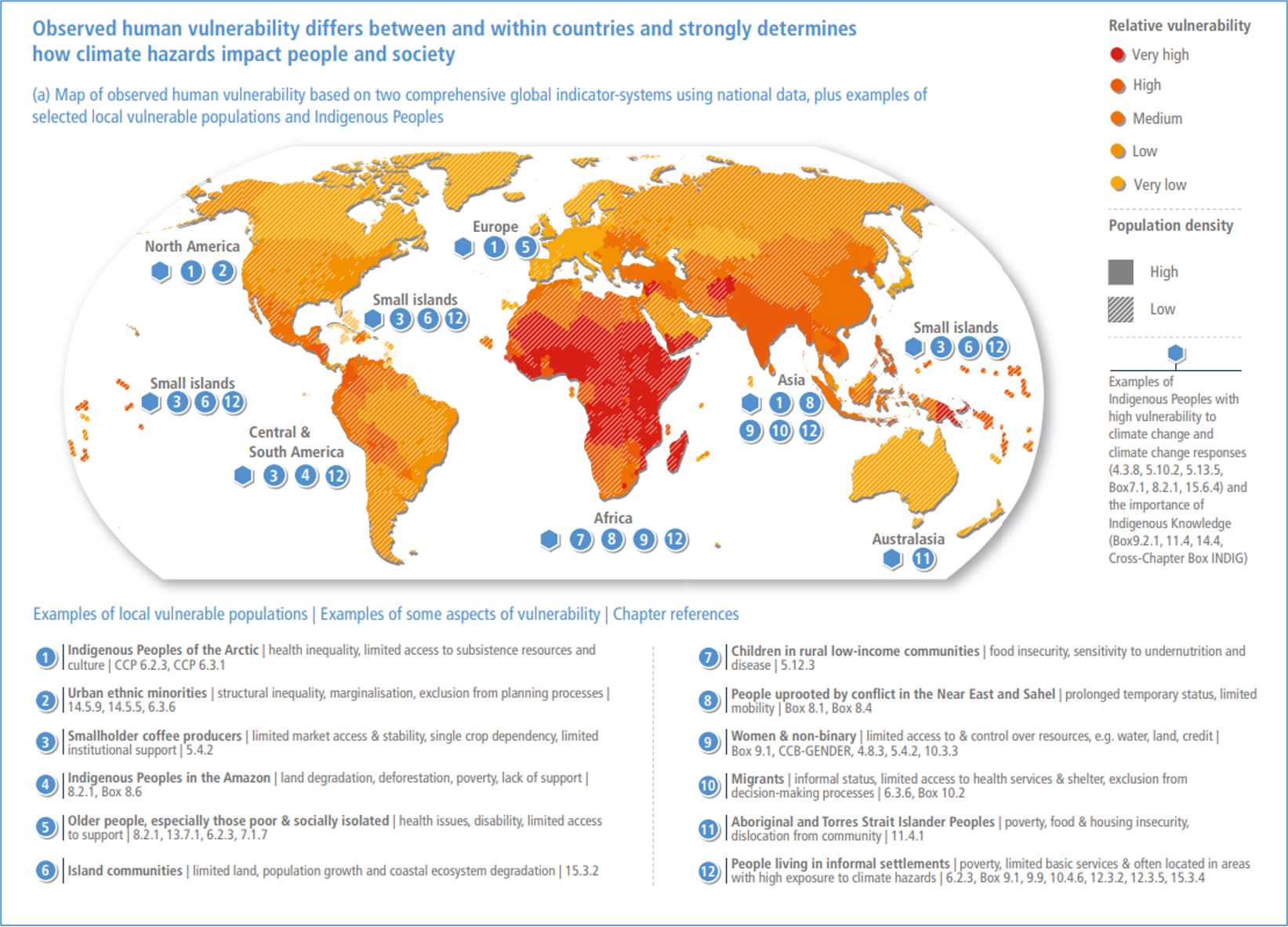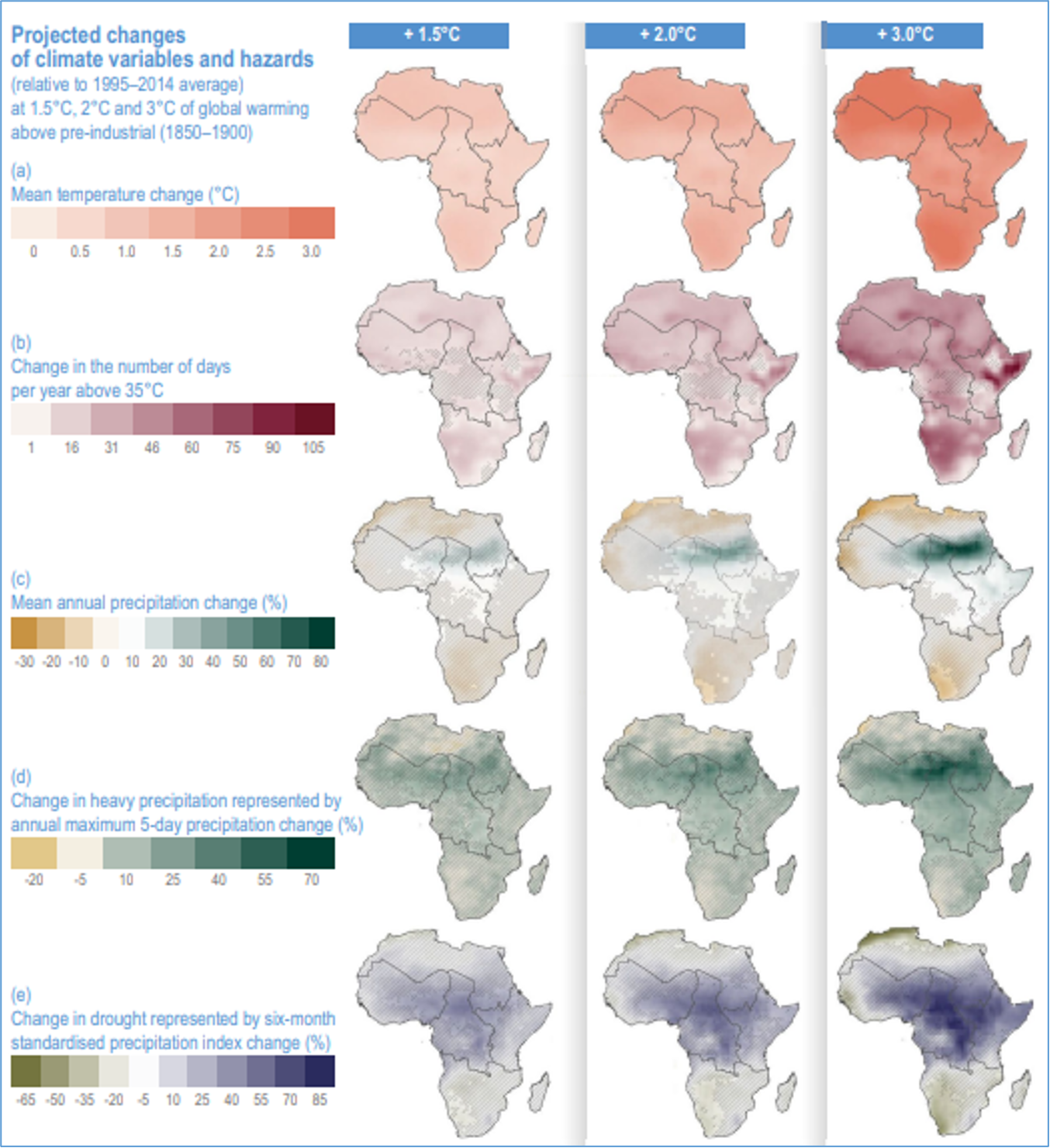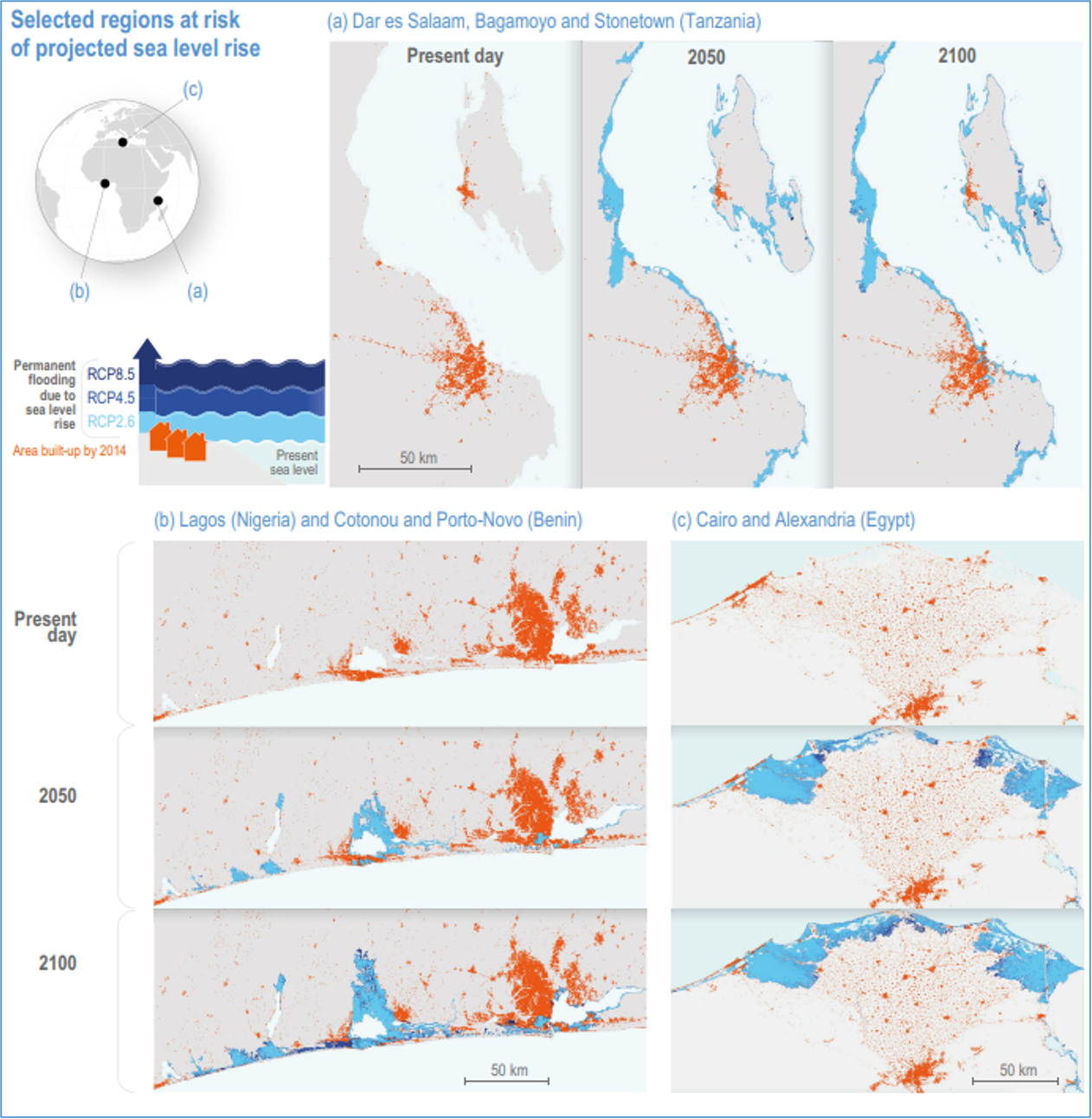“The 27th Conference of the Parties to the United Nations Framework Convention on Climate Change (COP27)”, held in Sharm El Sheikh, Egypt, in November 2022, provided an opportunity to raise global awareness of climate change. While "mitigation" to reduce the impact of climate change by reducing greenhouse gas emissions and "adaptation" to cope with the inevitable environmental changes caused by climate change have been discussed, the phrase "loss and damage" was the main focus as a measure to support countries that are unable to take even "adaptation" measures[1]. What impact will climate change have on Africa, and especially in the context of conflict? This article will discuss these points and introduce possible responses and measures that are under consideration.
Global state of climate change
The Sixth Assessment Report (AR6) of the Intergovernmental Panel on Climate Change (IPCC), released in February 2022, analyzes the impact of climate change by specifically addressing temperature changes since the pre-industrial era (1850-1900) under a variety of scenarios[2]. The Paris Agreement, concluded at the 21st Conference of the Parties to the United Nations Framework Convention on Climate Change (COP21) in 2015, set a goal of limiting temperature increase to 1.5 degrees Celsius by the end of the century, and COP27 reaffirmed this goal. However, as of 2022 the temperature increase had already reached 1.15 degrees (±0.13 degrees)[3], so meeting this target will not be easy. In the absence of adequate climate change measures (under AR6 scenario SSP3-7.0), the temperature will rise 3.6 degrees by the end of the century (2.8-4.6 degrees in the assumed range)[4]. At conferences on climate change, debate has centered on how close the temperature rise could be kept to the 1.5-degree target, and how the negative effects of climate change could be minimized.
Implications for Africa: impact of climate change
What does climate change mean for Africa? Africa has the lowest carbon dioxide (CO2) emissions in the world, yet it is the most severely affected[5] (see Figure 1). This is the starting point for the "loss and damage" debate, which argues that developed countries, which have caused temperature increases, should pay their share of the burden and work on climate change measures in developing countries, which suffer most.

(Figure 1 Vulnerability to Climate Change, [Source: IPCC 6th Assessment Report Working Group II Technical Summary, p. 76]) (Note: Vulnerability is measured by integrating data for each country and the existence of vulnerable groups such as indigenous peoples)
What specific impact will climate change have? The following will mainly occur on the African continent,
- Rising temperatures: Higher temperatures will lead to prolonged periods of hot days (temperatures higher than 35 degrees), increasing mortality risks[6], negative economic output due to lower labor productivity[7], and more sea level rises[8] that will cause flooding in major coastal cities.
- Climate cycle changes: Climate change will alter the climate cycle, increasing the frequency of extreme weather events. This is expected to lead to increased droughts, torrential rains, dust storms, and strong winds[9]. Greater rainfall will increase the frequency of floods, which will wash away surface soil, resulting in the loss of fertile soil and reduced water retention capacity. Land with reduced water retention capacity further increases the risk of flooding. It is noteworthy that heavy rains and drought risk occur in almost the same areas on the southern edge of the Sahara Desert[10] (see (d) and (e) in Figure 2).

(Figure 2: Climate Change Disaster Vulnerability Projections, [Source: IPCC 6th Assessment Report Working Group II Africa, p. 1324) (Note: from top: a) change in temperature, b) change in hot days above 35 degrees, c) change in annual precipitation, d) change in heavy precipitation with maximum 5 days of rainfall per year, e) drought)
- Water scarcity: Water scarcity is an issue not only in areas of drought and desertification, but also in areas where heavy rains occur. Water is washed away with floods, resulting in water scarcity for agriculture and domestic use. The amount of water available per capita is expected to be even lower in Africa, where the population is rapidly growing[11].
- Impact on agricultural production and food crises: Changing climate cycles and water shortages will severely damage crop production, resulting in frequent food crises.
- Impact on health systems: Diseases such as malaria will spread and place a heavy burden on health care systems[12].
- Migration: People in regions where life is difficult due to climate change will move and migrate in search for better living conditions[13]. This will change the social environment of the destination areas and countries, and combined with the impact of Africa's population growth, the concentration of population in urban areas, especially on the coasts, will become a major social issue[14].
These are the main scenarios that are envisioned for Africa.
Impact in conflict areas
Conflict zones in Africa are expected to be even more severely affected.
In the Sahel region of West Africa, rising temperatures will make life more difficult due to the increase of high temperature days. Although recent observational data have shown that water storage in the region is increasing and desertification is receding, conditions that have been called the "Sahel Paradox,"[15] vegetation is shifting from short grasses to shrubs, and the decrease in grasses for livestock feed is impoverishing the livelihoods of nomadic people[16]. The enclosure of land by farmers and sedentary pastoralists has reduced the area available for nomadic grazing, leaving nomads in the most vulnerable position[17]. This is likely to become more severe in the future.
In the Horn of Africa, Somalia will experience more hot days[18] and more severe droughts. Both farmers and herders are being negatively impacted, and recruitment by the armed group al-Shabaab[19] is inducing people to become members in search of livelihood. Currently, despite increased U.S. and other counterterrorism support, al-Shabaab's influence has not diminished, and the risk of conflict may increase further in the future.
The area around Lake Chad is another conflict risk area. Lake Chad is shallow, and depending on rainfall in the surrounding area, there is a risk that the lake could disappear. At the same time, the area could expand due to water inflows from rainfall and the residents of the surrounding area could be affected[20]. Lake Chad is a valuable source of water for the people living in the surrounding area, but the area is poor, and many have joined the armed forces in order to survive[21]. There is also a risk that the salinity of the lake will increase due to evaporation, making it unavailable for drinking and agricultural use. Further monitoring of environmental change is needed in this area.
Widespread risk of conflict emergence
Climate change may increase people's deprivation and increase the risk of conflict in previously peaceful areas. Of particular concern are the coastal areas and the Central and Southern Africa region.
Of the coastal areas, particular attention should be paid to urban areas in Nigeria[22], Cote d'Ivoire, Benin, and Senegal[23], as well as Dar es Salaam[24] in Tanzania and Cairo in Egypt. These areas have high population concentrations and residential areas are spread out in places at high risk of flooding. Urban population concentration is one of the most serious concerns in Africa due to rapid population growth[25] and human migration to urban areas. Climate change is expected to cause sea level rises, which will make inundation more severe than ever[26] (see Figure 3).

(Figure 3: Impact of Sea Level Rise on Coastal Areas, [Source: IPCC 6th Assessment Report Working Group II Africa, p. 1365]) (Note: Orange indicates areas with man-made structures (where people live) as of 2014; blue indicates areas expected to be permanently inundated.)
The Central and Southern Africa regions have been rich in agricultural production, but climate change will cause severe damage to agriculture through heavy rains, floods[27], and droughts[28], which will reduce soil fertility and water retention[29].
Will climate change increase conflict?
Climate change increases the risks of conflict[30]. Conflicts may become more severe in areas where they are currently occurring. However, climate change is not directly linked to the occurrence of conflict[31]. This is because conflicts occur because of struggles over resources or the interests among parties involved, or because of an outbreak of dissatisfaction by resistance groups. As climate change is often a gradual and longer-term phenomenon, it can be an indirect factor in conflicts, but it rarely serves as the direct trigger. This is clear when one looks at cases in Southeast Asia and South Asia, where natural disasters such as floods do not lead to conflicts if appropriately managed. This fact is indicative that conflict can be avoided if governments provide fair and adequate services to the people, and the people share a sense of coexistence.
Necessary measures and policies
In order to address to climate change, it is necessary to engage in "mitigation" to control the rise in temperature. It is also necessary to take "adaptation measures” to cope with environmental changes. Examples of effective adaptation measures include policies to avoid population concentration in coastal areas and to change and improve agricultural practices to accommodate climate change. The Norwegian Refugee Council, an international non-governmental organization, is trying to improve the water retention capacity of land in Sudan by creating small holes in the topsoil and planting vegetation around them to retain inundated water and use it for farming. While numerous attempts have been made at adaptation measures, it is necessary to encourage the further development and promotion of such challenges.
Improved data collection and analysis of climate change is also needed. The effects of climate change are still unclear in many areas. Data collection and analysis in Africa is still fragile and in some places has even worsened[32]. More capacity building for data collection and analysis and the reflection of data in national policies are needed.
We must recognize that the issues of climate change are different from conventional humanitarian and development issues in terms of their scale and impact. The impact of climate change is global and cannot be addressed by a single country. It also requires a long-term and large-scale response, and fragile states that are in the midst of conflict cannot afford to take the necessary measures. As mentioned earlier, Africa is the most vulnerable region despite having the lowest CO2 emissions. Recognizing this reality and understanding that climate change requires a comprehensive response by all countries, the international community, especially developed countries, should take the lead in addressing climate change in Africa. In terms of finance, many African countries are now facing heavy debt burdens after the COVID-19 pandemic. Grant assistance, rather than new lending, is one option.
In addition, while addressing climate change requires a grand vision for a response, it is also important to have deliberate monitoring capacities on its environmental effects in local contexts, as well as information sharing[33] and encouragement of ownership among local stakeholders. The Great Green Wall Project has been conducted with the support of the African Union (AU) and other organizations. A 7,000-kilometer tree belt has been established from West Africa to the Horn of Africa and more than 20 million trees have already been planted, but some analysts argue that this project has had a negative impact on the livelihoods of nomads and the vulnerable[34]. The response to climate change requires a grand design, but sustainable results cannot be achieved unless accompanied by sensitive impact assessment.
JICA's climate change initiatives are aimed at (1) promoting the implementation of the Paris Agreement and (2) promoting co-benefit projects[35]. With regard to (1), JICA aims to support the development, update, and implementation of climate change policies and plans in more than 10 countries by 2030, and to train more than 10,000 personnel to translate the Paris Agreement into concrete action. Regarding (2), JICA aims to implement more than 500 co-benefit projects, which address simultaneously development challenges and climate change, such as developing geothermal plants and constructing flood control measures, and reduce the amount of green-house gas emission to 2 million tons of CO2 equivalent per year by 2030. In Sudan, JICA supports Integrated Water Resource Management (IWRM), which makes it possible to measure the current volume of water resources (both groundwater and surface water) in respective areas and make projections for the future[36]. As for adaptation, collaborating with Tottori University and other academies, as well as the Japan Science and Technology Agency (JST), JICA develops new wheat varieties that are tolerant of the high temperatures and dry conditions in Sudan[37]. However, further actions in collaboration with other countries and institutions are needed to promote climate change countermeasures.
The global population has tripled between 1950 and the present, and the demand for water has increased eight-fold since 1900[38]. The number of conflicts doubled from 2010 to 2020[39], and ‘forcibly displaced’ persons exceed 100 million. Population growth and economic development place a tremendous burden on the Earth, making people’s lives more difficult. In order for human beings to continue to live happily, it is indispensable to create a system in which humans and the Earth can coexist by reducing the environmental burdens on the planet. To this end, addressing climate change is a serious issue that requires immediate action.
The views expressed in this paper are the author's and do not represent the official views of the organization to which the author belongs.
(2023/02/10)
Notes
- 1 “COP27: What was achieved, and what needs to happen now,” Chatham House, November 20, 2022.
- 2 “Climate Change 2022: Impacts, Adaptation and Vulnerability (IPCC 6th Assessment Report (AR6) Working Group II), Technical Summary,” Intergovernmental Panel on Climate Change (IPCC), February 28, 2022, p.44.
- 3 “WMO Provisional State of the Global Climate 2022,” World Meteorological Organization (WMO), November 7, 2022, p.3.
- 4 “Climate Vulnerable Monitor 3rd Edition: A Planet on Fire,” Climate Vulnerable Forum & V20, November 2, 2022, p.32.
- 5 “Climate Change 2022: Impacts, Adaptation and Vulnerability (IPCC 6th Assessment Report (AR6) Working Group II), Africa,” Intergovernmental Panel on Climate Change (IPCC), February 28, 2022, p.1289; “Ecological Threat Report 2022,” Institute for Economics & Peace, October 2022, pp16-17, 20; see footnote4, p32; Nasmot Gbadamosi, “If COP27 Fails, Africans Stand to lose the Most,” Foreign Policy, November 9, 2022.
- 6 See footnote 5(AR6(Africa)), pp.1375-1378.
- 7 See footnote 5(AR6(Africa)), p.1399.
- 8 See footnote 3 , pp.9-10.
- 9 “Climate Change 2022: Impacts, Adaptation and Vulnerability (IPCC 6th Assessment Report (AR6) Working Group II), Deserts, Semiarid Areas and Desertification,” Intergovernmental Panel on Climate Change (IPCC), February 28, 2022, p.2207.
- 10 See footnote 5(AR6(Africa)), p.1324.
- 11 “G5 Sahel Region Country Climate and Development Report,” World Bank Group, June 2022, pp.38-39.
- 12 See footnote 5(AR6(Africa)), p.1399.
- 13 Migration is often seen as a measure that should be avoided because of the various burdens it could place on both migrating groups and host communities that receive them. However, it should be noted that some argue that migration is an effective adaptation action in response to climate change and should be considered as a policy for climate change adaptation. Migration is an important option for those who live in areas where it is difficult to sustain livelihoods due to high temperatures or where safety cannot be guaranteed due to conflicts. Ideal methods and outcomes need to be considered in each individual case.
Analysis suggests that impoverishment due to climate change will become a factor in both inducing and discouraging migration. Households that can afford to move are able to do so, but poor households are unable to do so because they lack the necessary funds. (For more details, see "Footnote 5 (AR6(Africa)), pp. 1391-1993"); See footnote 11, p.42. - 14 See footnote 11, p.32; See footnote 9,p.2197.
- 15 See footnote 9, p.2201.
- 16 See footnote 9, p.2209.
- 17 “Security Risks of Environmental Crisis: Environment of Peace (Part 2),” Stockholm International Peace Research Institute (SIPRI), December 2022, p.22.
Although some governments and aid agencies have proposed that nomadic pastoralists should be encouraged to settle, the IPCC6 (AR6) report points out that these actions require careful consideration because of the risk that it may lead to forced changes in culture and customs. The report also states that nomadic herding has a lower impact on climate change than sedentary pastoralism and merits are to be considered as a type of ideal adaptation measure to climate change. See footnote 9, p. 2210. - 18 See footnote 5(AR6(Africa)), p.1324; footnote 3, p.17.
- 19 For Al Shabaab, see below:“Al Shabaab,” Council on Foreign Relations, December 6, 2022
- 20 “Climate Change and Security in West Africa,” Igarape Institute, February 2021, pp.15-16.
- 21 “Environment of Peace: Security in a new era of risk,” Stockholm International Peace Research Institute (SIPRI), May 2022, p.10.
- 22 See footnote 5 (Ecological Threat), p. 47. Lagos, the capital of Nigeria, is projected to increase its population by 82% from 15.5 million in 2022 to 28.2 million in 2050.
- 23 See footnote 5(AR6(Africa)), p.1364; footnote 20, pp.5-9.
- 24 See footnote 5 (Ecological Threat), p. 47. Dar es Salaam, Tanzania, has a projected population increase of 118% from 7.5 million in 2022 to 16.4 million in 2050.
- 25 See footnote 5 (Ecological Threat), p. 38. Population projections (2020, 2050): Mali (20.3 mil, 44 mil (+117%); Burkina Faso (20.9 mil, 43.2 mil (+107%); Niger (24.1 mil, 68.5 mil (+184%)).
- 26 See footnote 5(AR6(Africa)), p.1364.
- 27 See footnote 5(AR6(Africa)), p.1320.
- 28 See footnote 5(AR6(Africa)), p.1367.
- 29 See footnote 4, pp.32,58,60,66,104; footnote 5(AR6(Africa)), p.1401; “Climate Change 2022: Impacts, Adaptation and Vulnerability (IPCC 6th Assessment Report (AR6) Working Group II), Annexes,” Intergovernmental Panel on Climate Change (IPCC), February 28, 2022, p.2836.
- 30 See footnote 17(SIPRI (Part2)), p.5; Kheira Tarif, “Climate Change and Violent Conflict in West Africa: Assessing the Evidence,” Stockholm International Peace Research Institute (SIPRI), February 2022, p.1.
- 31 See footnote 5(AR6(Africa)), p.1394; footnote 9, pp.2209-2210; “Environment of Peace: Security in a new era of risk,” Stockholm International Peace Research Institute (SIPRI), May 2022, p.10.; footnote 3,p.28.
- 32 See footnote 5(AR6(Africa)), pp.1321-1323.
- 33 See footnote 21, pp.69-70, 80.
- 34 “Enabling an Environment of Peace: Environment of Peace (Part 4),” Stockholm International Peace Research Institute (SIPRI), December 2022, pp. 45-47.
- 35 For Climate Change activities of JICA, see below.
- 36 For JICA’s IWRM project in Sudan, see below.
- 37 For JICA’s Wheat project in Sudan, see below.
- 38 See footnote 21, p.10.
- 39 See footnote 21, p.12.

